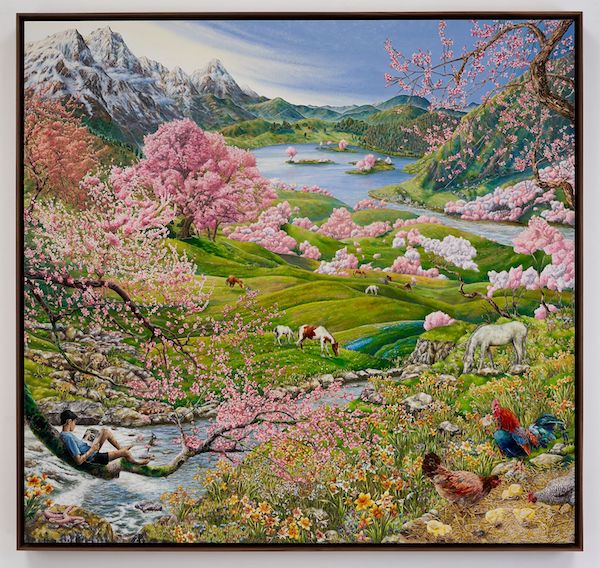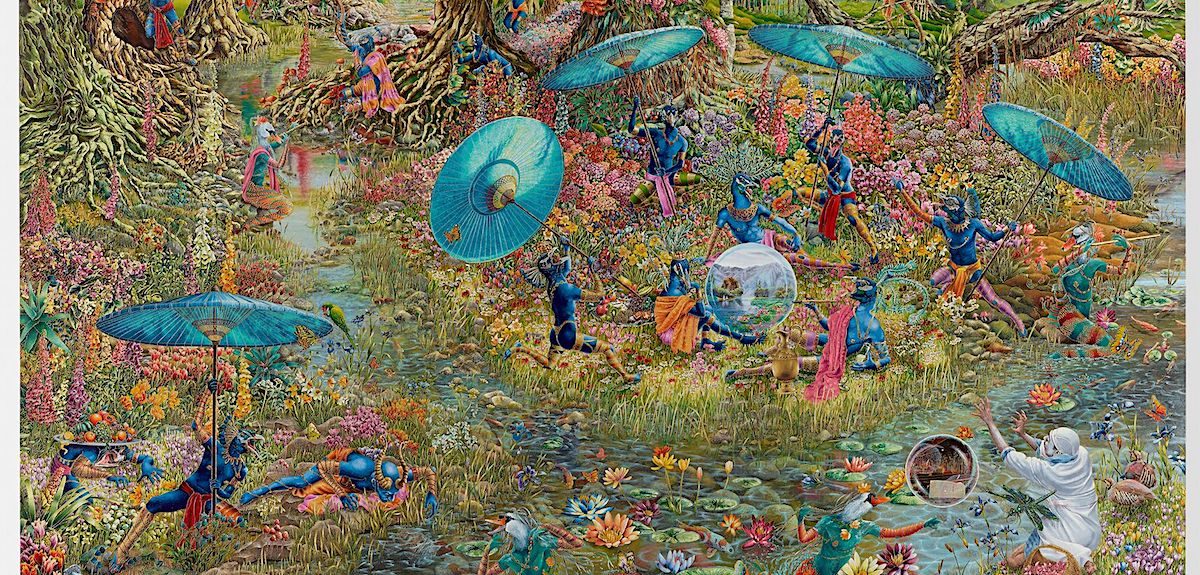Kashmiri born, London based Raqib Shaw has created his first dazzlingly immersive and multicultural landscape series. Renowned for his alchemy of Oriental opulence and Western
Renaissance brilliance, Shaw’s rich cultural heritage and expansive vision imbue this series with jewel-like palette and precision. His work has been shown at New York’s Metropolitan Museum, the Tate Britain and most recently, in 2018 at the Scottish Gallery of Modern Art, Edinburgh.
Raqib Shaw is an artist who is genuinely painting for the ages, not subject to the whims of contemporary cultural trends – IS
Maximalist, mystic and magician, the artist initially experimented with matchstick splinters, porcupine quills, and finally, needles to trace the most detailed areas of the paintings. Working with Hammerite enamel paint, which is initially used for iron and steel, Shaw outlines his images with gossamer lines of golden cloisonné. The brilliant palette recalls Kashmir’s explosively exquisite colours and ignites the incandescent and textural paint surfaces. Meticulously rendered images reference Annibale Carrac, John Constable, Casper David Friedrich, as well as Japanese prints and Persian and Mughal miniatures. The immersive show exhibits nine large acrylic liner and enamel on Birchwood paintings.

Personal history and mythology abound, enriching the work with sylvan fantasy. Bucolic mountain ranges, bubbling brooks, invented winged mythological figures are just some of the poetic details.
The series “Four Seasons” perfectly fulfils the artist’s quote, “All my paintings are showing my particular journey from the cradle to the grave.” The gorgeous “Spring” depicts Shaw as a dreaming boy nestled in a tree branch, immersed in reading an open illustrated book. Snowy Himalayan peaks are the background for the gloriously flowering trees, as grazing horses and new baby chicks celebrate spring’s renewal.
“Winter’ presents icy wraiths trapped in a gnarled tree, while winged, dragon-like demons torture the golden robed artist. Incised glaciers are as exquisitely rendered as the sensuously blooming pink springtime branches. The same illustrated book of “Spring” that fascinates the young Raqib is now splayed and frozen in a tangle of “Winter’s” tree roots.
“Allegory of Memory Through Monozukuri” shows the artist, white-faced, kimono robed and yielding a giant paintbrush, his Jack Russell dog by his side, a spirit companion. Heavily laden cherry blossoms provide shelter from a gossamer snowstorm. The title references monozukuri, the Japanese philosophy/mindset that illustrates a work ethic striving towards perfection.
Thanks, Raqib, for introducing this concept into my world.
Further kudos to an artist who is genuinely painting for the ages, not subject to the whims of contemporary cultural trends and conversations. Raqib Shaw tackles philosophical musings with a meditative, passionate and intimate mastery. His immense talents are transcendental.
Words: Ilka Scobie © Artlyst 2019 Photos: Courtesy Pace New York and Raqib Shaw
Raqib Shaw by Ilka Scobie LANDSCAPES OF KASHMIR Pace New York until May 18
Biography
Raqib Shaw (b. 1974, Calcutta) is known for opulent and intricately detailed paintings of fantastical worlds, often with surfaces inlaid with vibrantly coloured jewels and painted in enamel. His works reveal an eclectic fusion of influences—from Persian carpets and Northern Renaissance painting to industrial materials and Japanese lacquerware—and are often developed in series from literary, art historical, and mystical sources. Shaw has had solo exhibitions at Tate Modern, London (2006), The Metropolitan Museum of Art, New York (2008), Manchester Art Gallery (2013), Galerie Rudolfinum, Prague (2013), and the Scottish National Gallery of Modern Art, Edinburgh (2018). His exhibition at The Whitworth Art Gallery, The University of Manchester, United Kingdom (2017) was reimagined for the Dhaka Art Summit, Bangladesh, in 2018.

